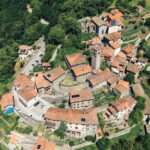As known Fosciandora has often been a border. Especially during the “Este” rule various enclaves were under the Duchy of Modena dominion (Ceserana, La Villa, Migliano, Fosciandora), while others were under the rule of Lucca (Riana, Treppignana, Lupinaia). The village of Fosciandora was the closest the border and therefore more subject and exposed to the battles between the two states armies. One of the most bloody events occurred in 1583, hnown as the “battle of la Maese”, by the name of an area between Fosciandora and Lupinaia.
“In 1583 the “este” armies, with troups from Fiumalbo and Pievepelago, led by valiant commanders, headed to and assaulted Lupinaia. At first it seemed that Lupinaia could resist, but then the Estensi prevailed and the village was set fire to. The following week, fearing the Lucca revenge, the stronghold of Ceserana was reinforced. Meanwhile militias from Perpoli and Riana had been long considering a vengeance for the torching of Lupinaia, arsoning the este village of Fosciandora. The deed however was difficult, as Fosciandora was fortified with two fortresses as ramparts, with a good numbered garrison and protected by the close defences Rocca di Ceserana and the Tower of Migliano. The Lucchesi therefore adopted a clever ploy: they gathered a troop of around 400 soldiers on a ground placed under Lupinaia, Maese. At night, at one o'clock a team reached and set fire to a place called Pretale, an area under Ceserana. The este forces all decended to Pretale to immediatly confront the arsonists, so leaving Fosciandora without defence... Once having realized the tricks success, the Lucchesi flocked to the assault of Fosciandora. The external fortresses were attacked first. The few left forces offered no resistance and took refuge in the village's centre. The surrounding land, the barns and the houses of the external circle were wrapped in flames, so it seemed that stones and water were aflame. In two hours all the houses and barns were completely destroyed, with victims even among children's mothers and the elderly. Lucca's revenge had been consumed”.
The reconstruction was completed in 1606, when the village was walled, protected with towers and completed with 5 strong doors.







